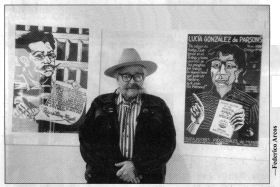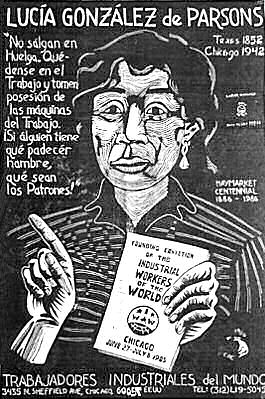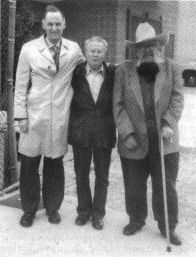Franklin Rosemont
Red In More Ways Than One
Carlos Cortez and the Native American/Wobbly Connection
2005
Throughout U.S. history, the lives and struggles of Native Americans have been disregarded and disdained by the white, middle-class, christian, capitalist, Nature-despising national Establishment. Sadly, the disregarders and disdainers also included the great majority of socialists, communists, anarchists, trade-unionists and others who considered themselves critics and opponents of that Establishment.

The IWW was the great exception. From the start, the One Big Union welcomed Native Americans, as they welcomed all people of color, and denounced their exploitation and persecution by Capital and the State. Here as elsewhere the Wobblies were inspired by their Abolitionist forebears (Wendell Phillips and Lydia Maria Child advocated especially radical views on what was then called the “Indian Question”) as well as the “Chicago Idea” anarchism of the 1880s (August Spies had lived with the Chippewas in Canada, and Albert Parsons and his wife Lucy, herself of Native American descent, were forceful agitators against U.S. government “anti-Indian” policies).
The early IWW press refers often to Native Americans, always in a spirit of revolutionary solidarity. Big Bill Haywood and Ralph Chaplin were prominent Wobs who proclaimed their admiration for the myths and lore and ways of life of those pioneer anarcho-communists, the indigenous Americans.
Historians regularly overlook them, but Native Americans made IWW history: Lucy Parsons, Frank Little, William Stanley, Frank Ellis and Lone Wolf are just a few. Along with Joe Hill, Sam Murray and others, Native American Wobs were active in the Mexican Revolution, fighting alongside the Magonistas for “Land and Liberty.” Later, large numbers of Native American farmers rallied to such IWW-influenced organizations as the Working Class Union, the Oklahoma Renters’ League and the Southern Tenant Farmers’ Union. Jack Sheridan, Fred Thompson, Carl Keller and other old-timers I met at the Chicago IWW hall in the 1960s more than once pointed out to me that whatever we enjoyed of democracy in this country we owed to the Iroquois rather than to Europeans.

Solidarity with Native Americans, and support for their struggles, was part of our education as young Wobblies. At a time when the Old and New Left couldn’t have cared less, we published—in the seventh issue of the Chicago IWW Branch magazine, The Rebel Worker—a stirring “Appeal to All” by a Native American defense group, the Survival of American Indians Association, based in the northwest. The statement concluded with the IWW watchword: “An Injury to One Is an Injury to All!”

The three are standing in front of a plaque commemorating the event which has been reconfigured by city officials as a “tragedy,” in which the lives of both workers and cops were lost rather than the class warfare it was. (photo Julie Herrada)
From the 1970s on, the many and profound Native American/Wobbly affinities were defended and illustrated above all by one remarkable fellow worker Carlos Cortez, who died last January at the age of 81. In his poetry and art, his Industrial Worker column and book reviews, his many interviews and appearances as public speaker—at elementary schools, high schools and universities as well as at May Day events and free-speech venues such as Bughouse Square and Slim Brundage’s College of Complexes—Fellow Worker Cortez again and again, in striking, colorful and infinitely varied ways, drove home the crucial point that all of us have “something to learn” from Native American culture, “a culture that had no jails, insane asylums, or power-mad rulers.”
As editor of the Industrial Worker, he explained more fully that he had written extensively about the Native American, partly because “[I am] a little ‘Red’ in more ways than one, and mainly out of the general idea of just plain human justice....We Wobblies have more than just a bleeding-heart interest in the Original American, since the tribal collective society they practiced, and still do wherever the Great White Mutha doesn’t interfere too much, is the same thing we want to see applied to modern industrial society.”
Fellow Worker Cortez was certainly the right man for the job. With Utah Phillips, he was far and away the most influential Wobbly of the past quarter century.
As the son of Mexican-Indian Wobbly organizer Alfredo Cortez, Carlos’s self-identification as Native American and rebel started early. When grade-school classmates mocked him as a Mexican, “like it was a dirty word,” his mother—a German socialist-pacifist poet—urged him to be proud of his ancestry. “Don’t let the children at school call you a foreigner,” she said, “because through your father you are Indian and that makes you more American than any of them.”
Immediately the youngster embraced his Mexican/Native American heritage, which he cherished the rest of his life. Interestingly, joining the IWW strengthened his “Indianness,” just as his self-awareness as Indian deepened his commitment to the Wobbly vision of worldwide working-class self-emancipation. For Carlos Cortez, these two aspects of his identity were fundamentally one, and nourished each other. He took his main pen-name, C.C. Redcloud, from the famed Oglala Sioux resister of white settler invasion. His other pseudonyms, Nuberoja and Punapilva, were Spanish and Finnish translations of Redcloud.
In the 1970s, with the rise of the American Indian Movement, Akwesasne Notes and other Native American periodicals, and films such as “Little Big Man,” a younger generation of radicals found Carlos Cortez an able and appealing mentor. As a soapbox poet, he had the knack of making strong points with high humor. Native Americans, he liked to explain, were “practicing ecology and the classless society for thousands of years before our ‘civilizers’ even had words for these things!” His last poster was a powerful linocut portrait of one of his heroes: Native American Wobbly organizer Frank Little.
Cortez regarded poetry as the highest art, and rebel poets as different as Ana Castillo, Diane di Prima and Dennis Brutus regarded him highly. Joseph Jablonski saluted him as “a pure embodiment of the Wobbly spirit” and an artist “defined by a total loyalty to fellow worker and fellow creature.” For Ojibwa poet E. Donald Two-Rivers, Carlos’s words “illustrate that we live in a world of possibilities.”
The Quahada Comanche poet/artist Lonnie Poco, Carlos’s longtime close friend (and author of Beside the Wichita), Fellow Worker Cortez was that all too rare phenomenon: “a man aware of his mission in life.”